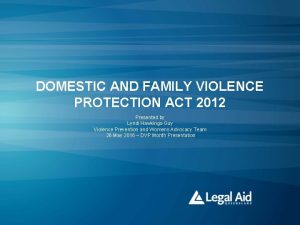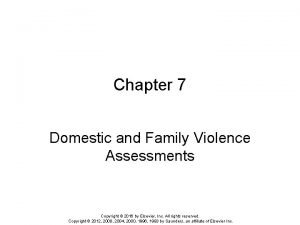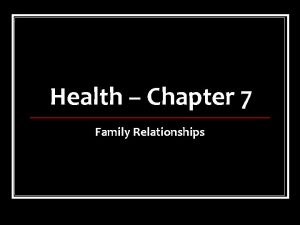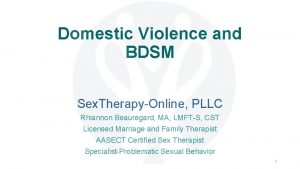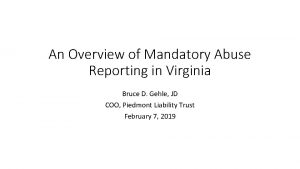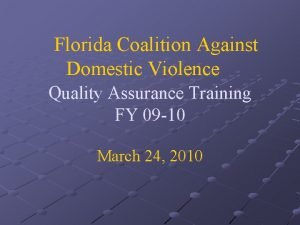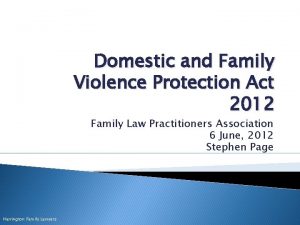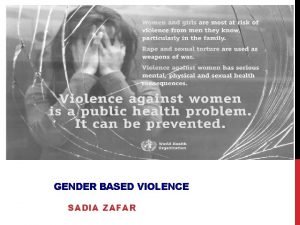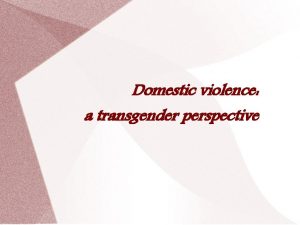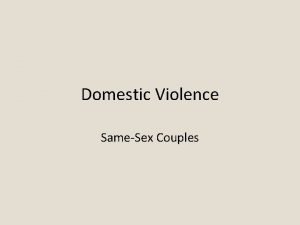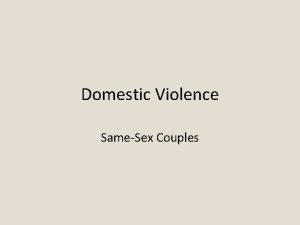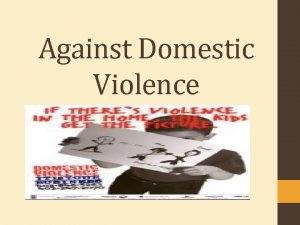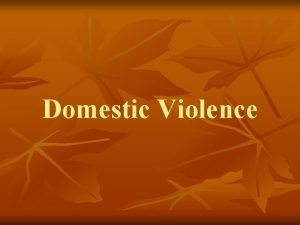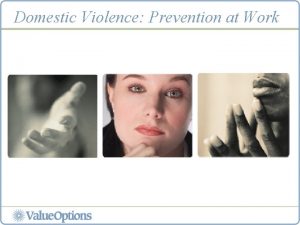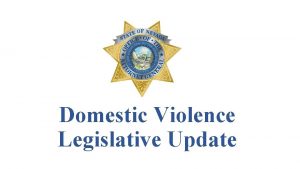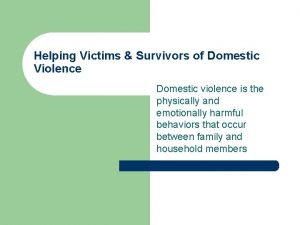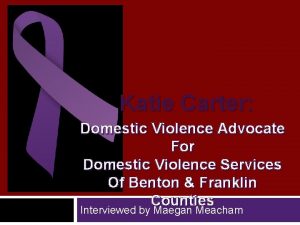Domestic violence a transgender perspective Defining Transgender Gender















- Slides: 15

Domestic violence: a transgender perspective

Defining Transgender Gender is a fundamental part of who we are We perceive ourselves and others through the lens of gender much of the time. A transgender person can be broadly defined as any person whose self identity falls outside of the heteronormative binary system of biologically assigned sex. Another simpler way to describe this concept is that a transgender identity is one where an individual lives and behaves as a member of the opposite gender to their birth sex

Dispelling the myths Gender identity and sexuality/sexual orientation are not the same issue; A transgender person is not a gay or lesbian individual who changes their gender in an attempt to normalise their sexuality; A transgender person is not a paedophile or sexually deviant; Gender dysphoria is not a mental illness nor is it an issue that limits a persons cognitive and academic abilities.

Violence and trans people Violence in a transgender persons life is often the “norm” rather than an unusual and shocking experience Acts of hate violence such as verbal abuse, harrassment, are often supported by socially sanctioned expressions of transphobia which are intended to send messages of exclusion. This perpetual experience of violence in a transgender persons life often creates in the feeling that unless a violent act leaves someone with extreme physical evidence of harm then the incident is not one worthy of intervention.

Domestic violence is a very real experience for transgender people Sara's story: “I had been dating my boyfriend for a while and we moved in together. He was the most amazing man, charming, loving and kind. Then he started to tell me I couldn't go out without him and I couldn't talk to any other males. I went out with friends one day, when I came home, he was so angry, he threw my belongings at me and screamed abuse, he told me that if I left him he would hunt me down and kill me. After this incident he started with constant verbal abuse, I was ugly, people knew I was a man, no one would want me cos' I am a freak, I am not a woman. He repeatedly forced me to have sex with him, even though I did not want to as he continued to threaten my life by either harming me himself or by exposing my status to people who would not respond well to the knowledge and seek to hurt me. ”

Some numbers to show the prevalence of domestic violence: In research titled “private lives” the statistics indicated that: 61. 8 % trans men 36. 4% trans women Reported having been in a relationship where their partner had abused them *Pitts M, Smith A, Mitchell A & Patel S (2006) Private lives: a report on the health and wellbeing of gay lesbian bisexual transgender and intersex Australians: Latrobe university

Common experiences of domestic violence For Transgender men and women the research indicates that the types of violence they experience is the same : *Pitts M, Smith A, Mitchell A & Patel S (2006) Private lives: a report on the health and wellbeing of gay lesbian bisexual transgender and intersex australians: Latrobe university

Common myths that need to be dispelled Domestic violence does occur within relationships where one or both partners are transgender If one person in the relationship is male to female this person can still be assaulted by their partner and the excuse that they are genetically male and can therefore defend themselves is inaccurate. It is domestic violence Trans people should just be happy to have a partner who accepts them and the associated abuse is therefore reasonable and acceptable

Family Violence Family violence is common theme emerging in anecdotal evidence regarding violence and transgender people. Young people in the family unit are often subjected to violence for a number of reasons such as to “combat” the behaviours exhibited by the transgender person…“to toughen him up and stop being girly”. Alternatively sibling violence is also reported as young people threaten to out or expose their transgender sibling status to community and peers or even parents for material gain or power and position within the family unit.

The challenges for families when someone is transgender When a family member or partner comes out as transgender there can be challenges in the family. Fear and blame are often the initial responses that people identify family members reporting. Shame and embarrassment often follow. The transgender person can at this time be at significant risk of violence within the family, the provision of information (in simple and straightforward language) can be a simple early intervention strategy to prevent family or domestic violence.

Service responses to domestic violence In responding to transgender victims of domestic and family violence, services are fraught with the potential of re-victimisation that is based in transphobia, religious prejudice, and even an adherence to the traditional heteronormative binary system of biological sex identification. All survivors of violence regardless of their identity need help to negotiate the manipulation tactics, harm and emotional trauma they have experienced at the hands of their partner/ family member.

Service responses to domestic violence A transgender woman who seeks help because of domestic violence is not in need of services and support from a service that supports male survivors of domestic violence. They need to be able to access services that understand support female survivors.

Simple ways to respond to a transgender survivor Use pronouns and language appropriate to the identified gender of the client Understand that a persons transgender identity is not their presenting issue when they come to your service Acknowledge and validate the persons discomfort at disclosing personal information, particularly as the person is waiting for you to respond negatively to their disclosure of gender diversity if you use wrong pronouns and language do not over apologise or expect your client to take responsibility for your feelings

Future directions One of the key projects the community case work team is focussing on in the next 12 months is the development of two new resources. One for services to give families and people when they or a family member are identified as experiencing gender identity issues The second is a resource for services on the key issues for transgender people who are survivors of violence to provide supports and services that meet the specific needs of the transgender community

The Gender centre's Transgender Anti violence program The Gender Centre in conjunction with the City of Sydney and the NSW police force are working on a campaign targeting violence experienced by transgender people: a reporting and support initiative that allows a transgender person to report the violence they have experienced either to the centre or to the police when further action is identified as wanted by the victim. Data collection and victimology studies form part of this program as well, to develop strategies in the future to respond effectively to the needs of transgender survivors of violence
 Domestic and family violence protection act 2012
Domestic and family violence protection act 2012 Chapter 7 domestic and family violence assessment
Chapter 7 domestic and family violence assessment Chapter 7 family relationships
Chapter 7 family relationships Domestic violence in the hispanic community
Domestic violence in the hispanic community Domestic violence kink
Domestic violence kink Virginia mandatory reporting law domestic violence
Virginia mandatory reporting law domestic violence Florida coalition against domestic violence
Florida coalition against domestic violence Domestic and family violence protection act 2012
Domestic and family violence protection act 2012 Pyramid of gender based violence
Pyramid of gender based violence Gender based violence
Gender based violence Defining non defining relative clauses
Defining non defining relative clauses Defining relative clause meaning in telugu
Defining relative clause meaning in telugu Relative clauses defining
Relative clauses defining Nonessential adjective clause
Nonessential adjective clause Where kullanımı relative clauses
Where kullanımı relative clauses Relative clauses defining and non defining
Relative clauses defining and non defining
